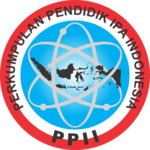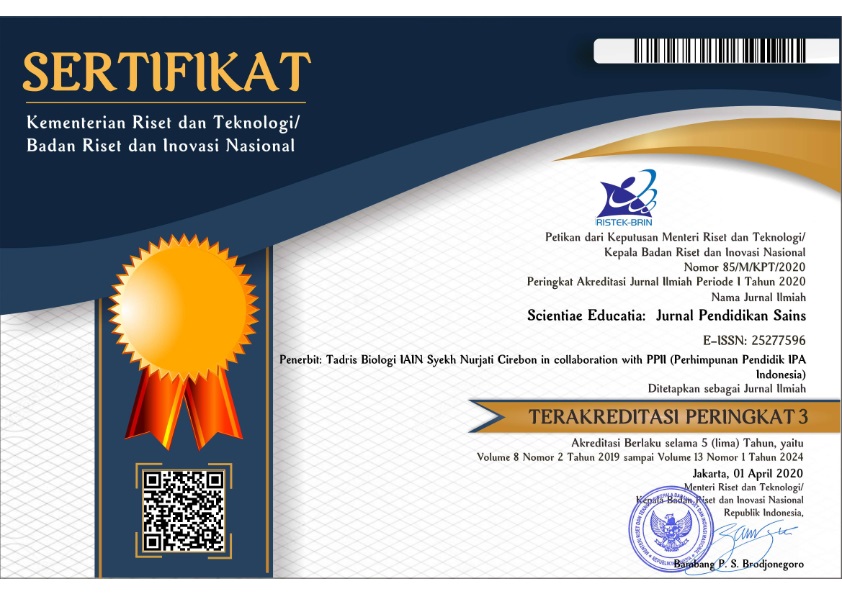Traditional Biotechnology Content as a Media in Engaging Students with System Thinking Skills
(1) Universitas Pendidikan Indonesia; UIN Sunan Gunung Djati Bandung
(2) Universitas Pendidikan Indonesia
(3) Pendidikan IPA/Pendidikan Biologi
(4) Pendidikan IPA/Pendidikan Biologi
(*) Corresponding Author
Abstract
Keywords
Full Text:
PDFReferences
Agustina, T.W., Rustaman, N.Y., Riandi, & Purwianingsih W. (2017a). Peranan Fisiologi Tumbuhan dalam Pengembangan Kemampuan Berpikir Sistem (STS). Prosiding Seminar Nasional Biologi 2. Bandung, 13 April 2017.
____________________________________________________. (2017b). The Learning of Compost Practice in University. Journal of Physics: Conference Series 895 012128, 1-7. DOI:10.1088/1742-6596/895/1/012128.
____________________________________________________. (2017c). The Teaching Problems in Biotechnology. A Preliminary Research Toward Teachers’ of Secondary School in East Bandung. 4th International Conference on Research, Implementation and Education of Mathematics and Science Proceedings.Yogyakarta, May 15th-16th, 2017. Tersedia Online: http://seminar.uny.ac.id/icriems/proceedings2017.
____________________________________________________. (2018a). Plant Physiology with Mathematic and Art Religion Engineering Science and Technology Approach. Advances in Social Science, Education and Humanities Research, 261, 43-47. DOI: 10.2991/icie-18. 2018.8.
____________________________________________________. (2018b). The learning of aquaponics practice in university. Journal of Physics: Conference Series 1013 012018, 1-7. DOI:10.1088/1742-6596/1013/1/012018.
Assaraf, O.B.Z., Jeff D., & Jaklin T. (2013). High School Students’ Understanding of The Human Body System. Journal Res Sci Edu 43, 33-56. DOI:10.1007/s11165-011-9245-2.
Azhari, M. (2014). Pemanfaatan Limbah Cair Tahu Menjadi Nata De Soya dengan Menggunakan Air Rebusan Kecambah Kacang Tanah dan Bakteri Acetobacter Xylinum [Tesis]. Surakarta: Universitas Sebelas Maret.
Bahri, N.M., Suryawati, E., & Osman, K. (2014). Students Biotechnology Literacy: The Pillars of STEM Education in Malaysia. International Society of Educational Research, 10(3), 195-207. DOI: 10.12973/eurasia.2014.1074a.
Basham, J.D., & Marino, M.T. (2013). Understanding STEM Education and Supporting Students Through Universal Design for Learning. Teaching Exceptional Children, 45, 8 15. Tersedia Online: https://www.researchgate.net/profile/Matthew_Marino2/
publication/275353986.
Boersma, K., Arend, J.W., Kees, K. (2011). The Feasibility of Systems Thinking in Biology Education. Journal of Biological Education, 45 (4), 190-197. DOI: 10.1080/00219266.2011.627139.
Bybee, R.W. (2010). Advancing STEM Education: A 2020 Vision. Technology and Engineering Teacher, 70 (1), 30-35. Tersedia Online: https://eric.ed.gov/?id=EJ898909.
___________ (2013). The Next Generation Science Standards and The Life Sciences. NSTA’s K-12 Journals. Tersedia Online: https://www.nsta.org.
Chabalengula, V.M., Martie, S., & Frackson, M. (2012). Diagnosing Students’ Understanding of Energy and Its Related Concepts in Biological Context. International Journal of Science and Mathematics Education, 10, 241-266. Tersedia Online: https://link.springer.com/article/10.1007/s10763-011-9291-2.
Cheng, L.T., Hung, J.F., & Liu S.Y. (2015). Using Systems Thinking Strategy in an Environment Course. US-China Education Review, 5(1), 46-51. DOI: 10.17625.
Dauer, J., & Dauer J. (2016). A Framework for Understanding The Characteristics of Complexity in Biology. International Journal of STEM Education, 3(13), 1-8. DOI: 10.1186/s40594-016-0047-y.
Dawidowicz, P. (2012). The Person on The Streets Understanding of Systems Thinking. Journal Systems Research and Behavioral Science, 29, 2-13. DOI: 10.1002/sres.1094.
De Sa freire, A., Xavier, M.C.F., & Moraes, M.O. (2013). High School Student’s Attitudes Assocciated with Biotechnology and Mollecular Genetics Concepts in Brazil. Creative Education, 4(2), 149-153. DOI: 10.4236/ce.2013.42021.
Dinas Pertanian & Ketahan Pangan Kota Bandung. (2017). Rencana Kinerja Tahunan Dinas Pertanian & Ketahanan Pangan Kota Bandung. Tersedia Online: https://ppid.bandung.go.id/?media_dl=18308.
Eilam, B. (2012). System Thinking and Feeding Relations: Learning with a Live Ecosystem Model. Journal Instr Sci, 40, 213–239. DOI: 10.1007/s11251-011-9175-4.
Erdogan, M., Ozel, M., Usak, M., & Prokop, P. (2009). “Development and Validation of an Instrument to Measure University Students’ Biotechnology Attitudeâ€. J. Sci Educ Technol., 18, 255-264. Tersedia Online: https://www.researchgate.net/publication/226016157.
Fraenkel, J.R. & Norman, E.W. (1990). How To Design and Evaluate Research In Education. United State : Mc.Graw Hill.Inc.
Habron, G., Lissy, G., & Laurie, T. (2012). Embracing The Learning Paradigm to Foster Systems Thinking. International Journal of Sustainability in Higher Education, 13, 378-393. DOI: 10.1108/14676371211262326.
Hartanto, A. (2018). Pacu Implementasi Making Indonesia 4.0, Ini 10 Langkah Prioritas. Tersedia Online: http://industri.bisnis.com/read/20180427/257/789095/pacu-implementasi-making-indonesia-4.0-ini-10-langkah-prioritas.
Hartley, L.M., Jennifer, M., April M., & Charlene, D.A. (2012). Energy and Matter: Differences in Discourse in Physical and Biological Sciences Can Be Confusing For Introductory Biology Students. BioScience, 62, 488-496. DOI: 10.1525/bio2012.62.5.10.
Hidayatno, A. (2013). Berpikir Sistem: Pola Berpikir untuk Pemahaman Masalah yang lebih baik. Tersedia Online: https://www.researchgate.net/publication/302412744.
Hsu. (2014). Perspective of STEM. Tersedia Online: http://perspectivestemeducation.com/ services.html.
Jho, H., Hong, O., & Song, J. (2016). An Analysis of STEM/STEAM Teacher Education in Korea with A Case Study of Two Schools from A Community of Practice Perspective. Eurasia Journal of Mathematics, Science and Technology Education, 12(7), 1843-1862. DOI: 10.12973/eurasia.2016.1538a.
Jordan, R.C., Silver, C.H., Liu, L., & Gray, S.A. (2013). Fostering Reasoning About Complex Systems: Using the Aquarium to Teach Systems Thinking. Applied Environmental Education & Communication, 12,55–64., DOI: 10.1080/1533015X.2013.797860.
Junge, R., Wilhelm, S., & Hofstetter, U. (2014). Aquaponic in Classrooms as A Tool to Promote System Thinking. 3rd Conference with International Participation Conference VIVUS on Agriculture, Environmentalism, Horticulture and Floristics, Food Production and Processing and Nutrition Proceedings. Naklo, November 14th - 15th , 2014. Tersedia Online: https://pd.zhaw.ch/publikation/upload/207533.pdf.
Karaman, A.C. (2014). Community Service Learning and the Emergence of Systems Thinking: A Teacher Education Project in an Urban Setting in Turkey. Syst Pract Action Res, 27, 485-497. DOI: 10.1007/s11213-013-9309-5.
Karno To & Wibisono, Y. (2004). Anates Program Khusus Analisis Tes Pilihan Ganda dan Uraian versi 4.0 untuk Window. Bandung: Universitas Pendidikan Indonesia.
Kementrian Pendidikan dan Kebudayaan (2013a). Kurikulum 2013 Kompetensi Dasar Sekolah Menengah Pertama (SMP)/ Madrasah Tsanawiyah (MTS). Jakarta: Kementrian Pendidikan dan Kebudayaan.
__________________________________ (2013b). Kurikulum 2013 Kompetensi Dasar Sekolah Menengah Atas (SMA)/ Madrasah Aliyah (MA). Jakarta: Kementrian Pendidikan dan Kebudayaan.
Kidman, G. (2009). Attitudes and Interest Towards Biotechnology: The Mismatch Students and Teachers. Eurasia Journal of Mathematics, Science and Technology Education, 5(2), 135-143. Tersedia Online: https://eprints.qut.edu.au/28904.
Larsen, Y.C, Jorge, G., & Franz, X.B. (2015). Doesâ€Thinking in System†Foster A Crossdisciplinary Understanding Of Energy?. European Scientific Journal, 2, 285-295. Tersedia Online:https://eujournal.org/index.php/esj/article/download/.../5707.
Madigan, M.T., Martinko J.M., Bender, K.S., & Stahl, D.A. (2009). Brock Biology Microorganisms Fourteen Edition. Boston: Pearson Education, Inc.
Meilinda, M., Rustaman, N. Firman, H., & Tjasyono, B. (2017). Development Climate Changes Lecturer in Earth Science and Space Course and Environmental Course for Pre-Service Science Teachers. Proceedings 2nd Asian Education Symposium. Mataram, 7th November 2017. Tersedia Online:http://www.scitepress.org
_______________________________________________ (2018). Development and validation of climate change system thinking instrument (CCSTI) for measuring system thinking on climate change content. Journal of Physics: Conference Series 1013 012046. DOI: 10.1088/1742-6596/1013/1/012046.
Meltzer, D.E. (2002). The Relationship between Mathematics Preparation and Conceptual Learning Gains in Physics : A Possible “Hidden Variable†in Diagnostic Pretest Scores. American Journal Physics, 70 (12), 1259-1286. DOI: 10.1119/1.1514215.
Misgiyarta. (2017). Produksi Nata De Soya dengan Substrat Limbah Cair Industri Tahu. Jakarta: Badan Penelitian dan Pengembangan Pertanian.
Movahedzadeh, F., Patwell, R., Rieker, J.E., & Gonzalez, T. (2012). Project-Based Learning to Promote Effective Learning in Biotechnology Courses. Education Research International, 1-8. DOI:10.1155/2012/536024.
Natsir, N.F. (2013). Paradigma Wahyu Memandu Ilmu dalam Pembidangan Ilmu-Ilmu Keislaman. Tersedia Online: http://www.uinsgd.ac.id/front/detail/mengenal_tokoh/nanat-fatah-natsir.
Nisa, K. (2016). Memproduksi Kompos dan Mikroorganisme Lokal (MOL). Jakarta: Bibit Publisher.
Nursani, Z. (2014). Analisis Argumentasi dan Penguasaan Konsep dalam Menggambarkan Keterampilan Berpikir Sistem pada Pembelajaran Fisiologi Manusia [Thesis]. Bandung: Universitas Pendidikan Indonesia.
Oner, A.T, Nite, S.B, Capraro, R.M., & Capraro, M.M. (2016). From STEM to STEAM: Students’ Beliefs About the Use of Their Creativity. The STEAM Journal, 2(2), 1-16. DOI: 10.5642/steam.20160202.06.
Pendidikan Biologi. (2015). Kerangka Kualifikasi Nasional Indonesia dan Profil Lulusan Pendidikan Biologi. Bandung: Fakultas Tarbiyah dan Keguruan UIN Sunan Gunung Djati. Tidak diterbitkan.
Raved, L., & Yarden, A. (2014). Developing Seventh Grade Students’ Systems Thinking Skills in The Context of The Human Circulatory System. Journal Frontiers in Publict Health, 2, 1-11. DOI: 10.3389/fpubh.2014.00260.
Rosicka, C. (2016). Translating STEM Education Research into Practice. Victoria: Australian Council for Educational Research.
Sembiring, I., Rustaman, N. & Rohman, I. (2017). Profile of the system thinking skills of junior high school students on the living organization system topic. Local Proceeding International Conference on Mathematics and Science Education. Tersedia Online: science.conference.upi.edu.
Septiani, A. (2016). Penerapan Asesmen Kinerja Dalam Pendekatan STEM Untuk Mengungkap Keterampilan Proses Sains. Isu-Isu Kontemporer Sains, Lingkungan dan Inovasi Pembelajarannya. Tersedia Online://publikasiilmiah.ums.ac.id.
Sodervik, I., Mirjamaija, M.E., & Henna, V. (2014). Promoting The Understanding of Photosynthesis Among Elementary School Student Teachers Through Text Design. J. Sci Teacher Educ, 25, 581-600. DOI: 10.1007/s10972-013-9373-9.
Sopian, H. (2015). Deskripsi Kemampuan Berpikir Logis dan Pemahaman Konsep Hormon pada Kelas XI SMA. Prosiding Seminar Nasional XII Pendidikan Biologi FKIP UNS. Tersedia Online: https://www.neliti.com.
Subandi, H.M. (2010). Mikrobiologi, Perkembangan, Kajian, dan Pengamatan dalam Perspektif Islam. Bandung: PT. Remaja Rosdakarya.
Subali, B., & Ellianawati. (2010). Pengaruh Waktu Pengomposan terhadap Rasio C/N dan Jumlah Kadar Air dalam Kompos. Prosiding Pertemuan Ilmiah XXIV Jateng & DIY. Tersedia Online: www.hfi-diyjateng.or.id.
Suwarma, I. R. (2014). A Research on STEM Education Theory and Practices Method in Japan and Indonesia Using Multiple Intelligence Approach. [Doctoral Thesis]. Shizuoka: Shizuoka University.
Thalbah, H., Zindani, A. M., Sayid, A.A. M., dkk. (2008). Ensiklopedia Mukjizat Al Quran dan Hadis, Jakarta: PT. Sapta Sentosa..
Thieman, W.J., & Palladino, M.A. (2009). Introduction to Biotechnology. San Fransisco: Pearson Education, Inc.
Toharudin, U., Hendrawati, S., & Rustaman, A. (2011). Membangun Literasi Sains Peserta Didik. Bandung: Humaniora.
Tripto, J., Orit, B.Z.A., & Miriam, A. (2013). Mapping What They Know: Concept Maps as an Effective Tool for Assesing Students’ System Thinking. American Journal of Operations Research, 3, 245-258. DOI: 10.4236/ajor.2013.31A022.
Usak, M., Erdogan, Prokop, P., & Ozel, M. (2009). High School and University Student’s Knowledge and Attitudes Regarding Biotechnology. Biochemistry and Molecular Biology Education, 37(2), 123-130. DOI: 10.1002/bmb.20267.
Verhoeff, R.P. (2003). Towards Systems Thinking in Cell Biology Education. Netherland: Omslag.
Wijaya, A. D., Karmila, N., & Amalia, M. R. (2015) Implementasi Pembelajaran Berbasis STEAM (Science, Technology, Engineering, Art, Mathematics) pada Kurikulum Indonesia. Proseding Seminar Nasional Fisika dan Aplikasinya. Tersedia Online: portal.phys.unpad.ac.id.
Zion, M., & Sara, K. (2015). Conceptual Understanding of Homeostasis. International Journal of Biology Education 2: 1-27. DOI: 10.20876/ijobed.12279.
Zollman, A. (2012). Learning for STEM Literacy: STEM Literacy for Learning. School Science and Mathematics, 112 (1), 12-19. DOI: 10.1111/j.1949-8594.2012.00101.x.
DOI: 10.24235/sc.educatia.v7i2.3099
Article Metrics
Abstract view : 425 timesPDF - 238 times
Refbacks
- There are currently no refbacks.
Scientiae Educatia: Jurnal Pendidikan Sains indexed by:

This work is licensed under a Creative Commons Attribution 4.0 International License.
Stat Counter (Link)



1.png)












